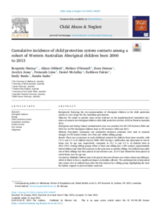Abstract:
Background
Reducing the over-representation of Aboriginal children in the child protection system is a key target for the Australian government.
Objective
The authors aimed to provide more recent evidence on the population-level cumulative incidence of contacts for Aboriginal children with child protective services (CPS) in Western Australia (WA).
Participants and Setting
Linked administrative data was provided for WA CPS between 2000 and 2015 for 33,709 Aboriginal children born in WA between 2000 and 2013.
Methods
Descriptive summaries and cumulative incidence estimates were used to examine changes in CPS contact trends over time and within sibling groups.
Results
There was an increase in early-childhood contacts for children born more recently, with 7.6 % and 2.3 % of children born in 2000–2001 having a notification and placement in out-of-home care by age one, respectively, compared to 15.1 % and 4.3 % of children born in 2012–2013. Among sibling groups where at least one sibling had a CPS contact, approximately half of children had their first contacts on the same date as another sibling. For children born after one of their siblings had been placed in out-of-home care, 31.9 % had themselves been placed in out-of-home care by age one.
Conclusions
Multiple children tend to be placed into out-of-home care when at least one sibling is, which is likely to have a significant impact on families affected. The additional risk of placement also carries over to children born after the first removal in a sibling group, highlighting the need for further support to prevent future removals.

